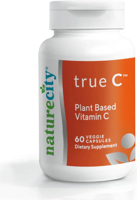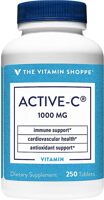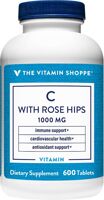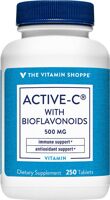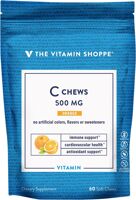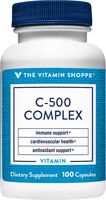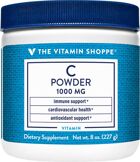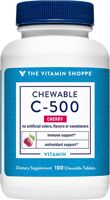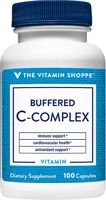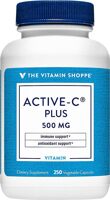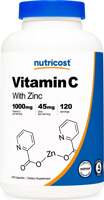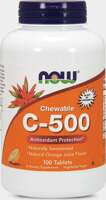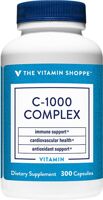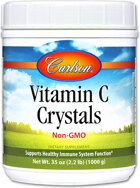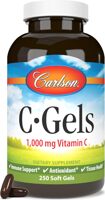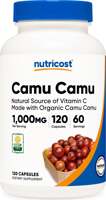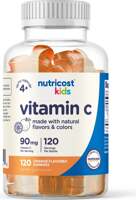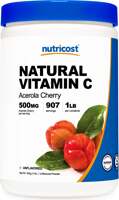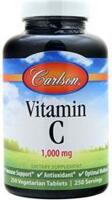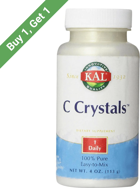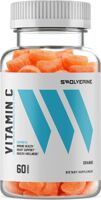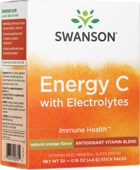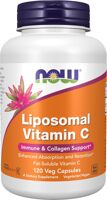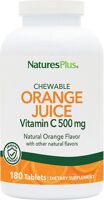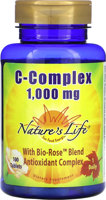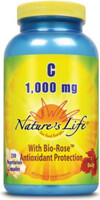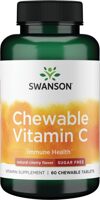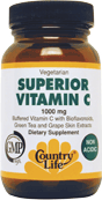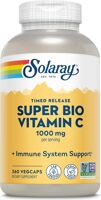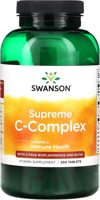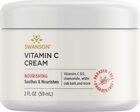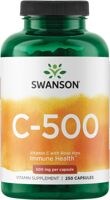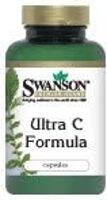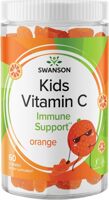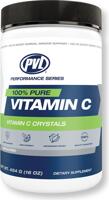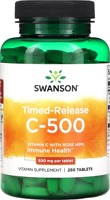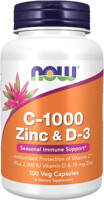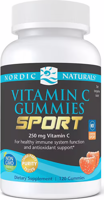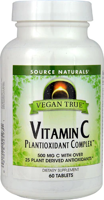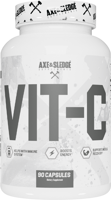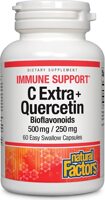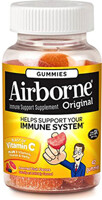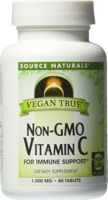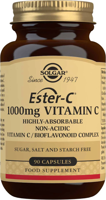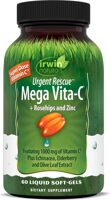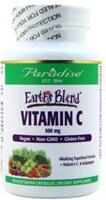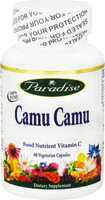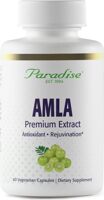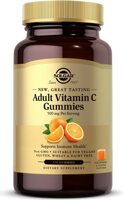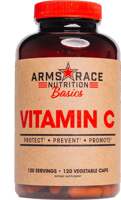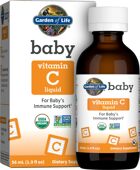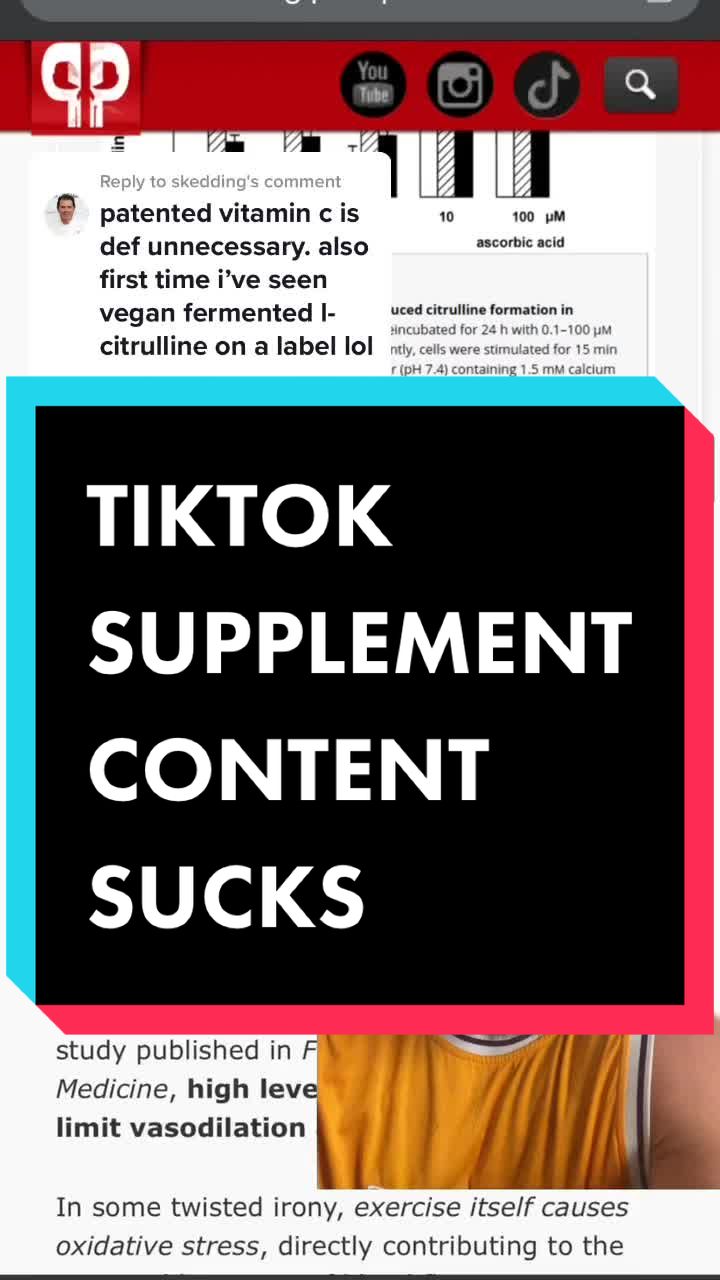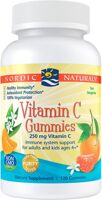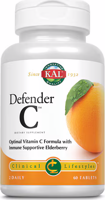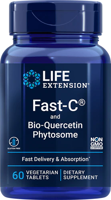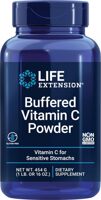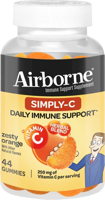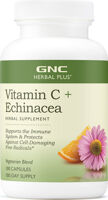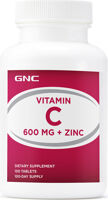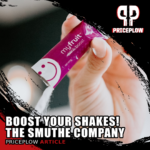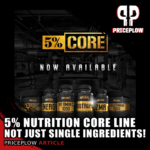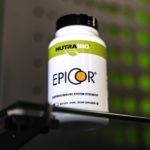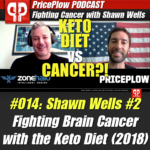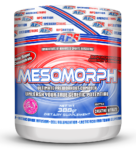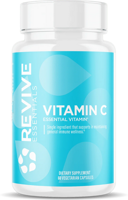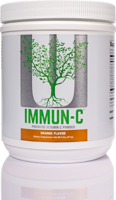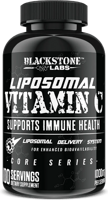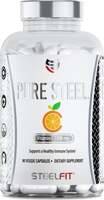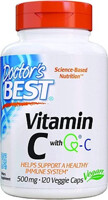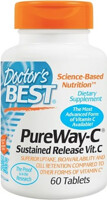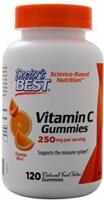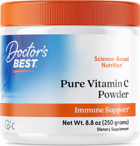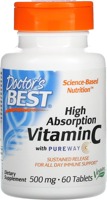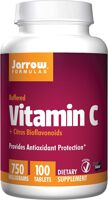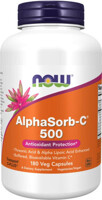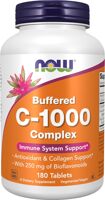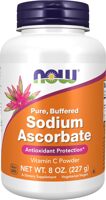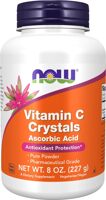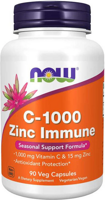Vitamin C News on PricePlow
-
Apr 19, 2024 ![]()
Product News
NatureCity TrueC was created.
Category: Vitamin C -
Mar 21, 2024 ![]()
Product News
The Vitamin Shoppe Vthrive - Liquid Liposomal Vitamin C was created.
Category: Vitamin C -
Feb 27, 2024 ![]()
Product News
The Vitamin Shoppe Active-C was created.
Category: Vitamin C -
Feb 24, 2024 ![]()
Product News
The Vitamin Shoppe Thrive - Liposomal Vitamin C was created.
Category: Vitamin C -
Feb 24, 2024 ![]()
Product News
The Vitamin Shoppe Vitamin C - Liquid was created.
Category: Vitamin C -
Feb 24, 2024 ![]()
Product News
The Vitamin Shoppe Vitamin C with Rose Hips was created.
Category: Vitamin C -
Feb 24, 2024 ![]()
Product News
The Vitamin Shoppe Active-C with Bioflavonoids was created.
Category: Vitamin C -
Feb 24, 2024 ![]()
Product News
The Vitamin Shoppe Vitamin C Chews was created.
Category: Vitamin C -
Feb 24, 2024 ![]()
Product News
The Vitamin Shoppe Vitamin C-500 Complex was created.
Category: Vitamin C -
Feb 24, 2024 ![]()
Product News
The Vitamin Shoppe Vitamin C Powder was created.
Category: Vitamin C -
Feb 24, 2024 ![]()
Product News
The Vitamin Shoppe Vitamin C was created.
Category: Vitamin C -
Feb 24, 2024 ![]()
Product News
The Vitamin Shoppe Buffered C-Complex was created.
Category: Vitamin C -
Feb 23, 2024 ![]()
Product News
The Vitamin Shoppe Active-C Plus was created.
Categories: Antioxidants, Immune System Supplements, Vitamin C -
Feb 19, 2024 ![]()
Product News
Nutricost Vitamin C has new variations: Category: Vitamin C -
Feb 18, 2024 ![]()
Product News
Healthy Origins Vitamin C has new variations: Category: Vitamin C -
Feb 18, 2024 ![]()
Product News
Swanson Vitamin C-1000 was created.
Category: Vitamin C -
Feb 11, 2024 ![]()
Product News
NOW C-500 has new variations: Category: Vitamin C -
Jan 29, 2024 ![]()
Product News
Trace Minerals Vitamin C + Ionic Zinc was created.
Categories: Vitamin C, Zinc -
Jan 27, 2024 ![]()
Product News
The Vitamin Shoppe Vitamin C-1000 Complex was created.
Categories: Antioxidants, Immune System Supplements, Vitamin C -
Jan 23, 2024 ![]()
Product News
Carlson Vitamin C Crystals has new variations: Category: Vitamin C -
Jan 21, 2024 ![]()
Product News
Carlson Vitamin C Crystals was created.
Category: Vitamin C -
Jan 21, 2024 ![]()
Product News
Carlson Vitamin C-Gels was created.
Category: Vitamin C -
Jan 11, 2024 ![]()
Product News
Nutricost Camu Camu was created.
Category: Camu Camu -
Jan 08, 2024 ![]()
Product News
Nutricost Vitamin C (for Kids) was created.
Categories: Gummy Supplements, Vitamin C, Vitamins for Kids -
Jan 08, 2024 ![]()
Product News
Nutricost Natural Vitamin C was created.
Category: Vitamin C -
Jan 08, 2024 ![]()
Product News
Nutricost Vitamin C was created.
Category: Vitamin C -
Jan 07, 2024 ![]()
Product News
Carlson Vitamin C was created.
Categories: Gummy Supplements, Vitamin C -
Dec 27, 2023 ![]()
Product News
KAL Vitamin C Crystals has new variations: Category: Vitamin C -
Dec 27, 2023 ![]()
Product News
Swolverine Vitamin C was created.
Categories: Gummy Supplements, Vitamin C -
Dec 26, 2023 ![]()
Product News
Swanson Energy C with Electrolytes has new variations: Categories: Electrolytes, Immune System Supplements, Vitamin C -
Dec 24, 2023 ![]()
Product News
NOW Liposomal Vitamin C was created.
Category: Vitamin C -
Nov 26, 2023 ![]()
Product News
Nature's Plus Orange Juice Vitamin C Supplement has new variations: Category: Vitamin C -
Oct 30, 2023 ![]()
Product News
Nature's Life Vitamin C-Complex was created.
Category: Vitamin C -
Oct 30, 2023 ![]()
Product News
Nature's Life Vitamin C was created.
Category: Vitamin C -
Sep 24, 2023 ![]()
Product News
Healthy Origins Vitamin C was created.
Category: Vitamin C -
Sep 17, 2023 ![]()
Product News
American Nutraceuticals Vitality C was created.
Category: Vitamin C -
Jul 21, 2023 ![]()
Product News
Swanson Chewable Vitamin C was created.
Category: Vitamin C -
Jul 15, 2023 ![]()
Product News
Country Life Superior Vitamin C was created.
Category: Vitamin C -
Jul 10, 2023 ![]()
Product News
Solaray Vitamin C has new variations: Categories: Gummy Supplements, Vitamin C -
Jul 09, 2023 ![]()
Product News
Solaray Super Bio Vitamin C has new variations:- 100 Vcaps - 500mg Buffered +Immune System
- 100 Vcaps - Timed-Release Buffered
- 60 Vcaps - Timed-Release - 500mg
-
Jul 03, 2023 ![]()
Product News
Swanson Energy C with Electrolytes was created.
Categories: Electrolytes, Immune System Supplements, Vitamin C -
Jun 19, 2023 ![]()
Product News
Swanson Camu Camu Berries was created.
Categories: Antioxidants, Camu Camu -
Jun 16, 2023 ![]()
Product News
Swanson Supreme C-Complex with Citrus Bioflavonoids and Rutin was created.
Categories: Rutin, Vitamin C -
Jun 12, 2023 ![]()
Product News
Swanson Vitamin C Cream was created.
Categories: Skin Care, Vitamin C -
Jun 10, 2023 ![]()
Product News
Swanson Vitamin C-500 was created.
Category: Vitamin C -
Jun 10, 2023 ![]()
Product News
Swanson Ultra C Formula was created.
Categories: Immune System Supplements, Vitamin C -
Jun 04, 2023 ![]()
Product News
Swanson Liposomal Vitamin C was created.
Categories: Immune System Supplements, Vitamin C -
Apr 26, 2023 ![]()
Product News
Swanson Kids Vitamin C was created.
Categories: Gummy Supplements, Vitamin C, Vitamins for Kids -
Apr 21, 2023 ![]()
Product News
PVL Vitamin C was created.
Category: Vitamin C -
Apr 13, 2023 ![]()
Product News
Swanson Timed-Release C-500 was created.
Category: Vitamin C -
Mar 26, 2023 ![]()
Product News
NOW C-1000 Zinc & D-3 was created.
Categories: Vitamin C, Vitamin D3, Zinc -
Mar 05, 2023 ![]()
Product News
Swanson Vitamin C was created.
Categories: Gummy Supplements, Vitamin C -
Mar 03, 2023 ![]()
Product News
Swanson Vitamin C Powder was created.
Category: Vitamin C -
Feb 23, 2023 ![]()
YouTube Video
What is Ergothioneine? 3 Minutes to Understand MitoPrime -
Feb 23, 2023 ![]()
YouTube Video
Glaxon Collagen Updated: 5 Things to Love -
Feb 17, 2023 ![]()
YouTube Video
Ghost Glow Remastered: Look Good, Feel Great -
Feb 01, 2023 ![]()
YouTube Video
A Multivitamin with MitoPrime, SAMe, & Boron! Glaxon Multi+ -
Jan 22, 2023 ![]()
Product News
Solaray Rose Hips was created.
Categories: Immune System Supplements, Vitamin C -
Jan 20, 2023 ![]()
YouTube Video
Soul Performance Bliss Revitalize Collagen: A New Way to Collagen -
Jan 19, 2023 ![]()
YouTube Video
Kaged Mindset Unboxing: Find your FLOW -
Jan 08, 2023 ![]()
Product News
Nordic Naturals Vitamin C Gummies Sport was created.
Categories: Gummy Supplements, Vitamin C -
Jan 08, 2023 ![]()
Product News
Source Naturals Vegan True - Vitamin C was created.
Category: Vitamin C -
Jan 08, 2023 ![]()
Product News
Source Naturals Mega C-B-R was created.
Categories: Immune System Supplements, Vitamin C -
Dec 18, 2022 ![]()
Product News
Source Naturals Wellness C-1000 was created.
Category: Vitamin C -
Dec 14, 2022 ![]()
Product News
Axe & Sledge VIT-C was created.
Category: Vitamin C -
Dec 12, 2022 ![]()
Product News
Natural Factors C Extra + Quercetin was created.
Categories: Quercetin, Vitamin C -
Dec 11, 2022 ![]()
Product News
Airborne Kids Blast of Vitamin C was created.
Categories: Gummy Supplements, Vitamin C, Vitamins for Kids -
Dec 11, 2022 ![]()
Product News
Airborne Blast of Vitamin C - Gummies was created.
Categories: Gummy Supplements, Vitamin C -
Dec 10, 2022 ![]()
Product News
Source Naturals Vegan True - Non-GMO Vitamin C was created.
Category: Vitamin C -
Dec 09, 2022 ![]()
Product News
Solgar Ester-C was created.
Category: Vitamin C -
Oct 23, 2022 ![]()
Product News
Irwin Naturals Vita-C Plus was created.
Category: Vitamin C -
Sep 26, 2022 ![]()
Product News
Paradise Herbs Earth's Blend Vitamin C was created.
Category: Vitamin C -
Sep 26, 2022 ![]()
Product News
Paradise Herbs Camu Camu was created.
Category: Camu Camu -
Sep 26, 2022 ![]()
Product News
Paradise Herbs Amla was created.
Categories: Gut Health Supplements, Vitamin C -
Sep 21, 2022 ![]()
Product News
Solgar Adult Vitamin C Gummies was created.
Categories: Gummy Supplements, Vitamin C -
Jul 28, 2022 ![]()
Product News
Arms Race Nutrition Vitamin C was created.
Category: Vitamin C -
Jul 24, 2022 ![]()
Product News
Garden of Life baby - Vitamin C Liquid was created.
Category: Vitamin C -
Jul 24, 2022 ![]()
Product News
Garden of Life mykind Organics - Vitamin C was created.
Category: Vitamin C -
Jul 22, 2022 ![]()
TikTok Video
Replying to @skedding #greenscreen -
Jul 21, 2022 ![]()
Product News
Nordic Naturals Vitamin C Gummies was created.
Categories: Gummy Supplements, Vitamin C -
Jun 24, 2022 ![]()
Product News
KAL Reacta-C was created.
Category: Vitamin C -
Jun 23, 2022 ![]()
Product News
KAL Vitamin C Crystals was created.
Category: Vitamin C -
Jun 23, 2022 ![]()
Product News
KAL Vitamin C Acid-Free was created.
Category: Vitamin C -
Jun 21, 2022 ![]()
Product News
KAL Defender C was created.
Categories: Immune System Supplements, Vitamin C -
Jun 17, 2022 ![]()
Product News
KAL Vitamin C was created.
Category: Vitamin C -
Jun 14, 2022 ![]()
Product News
Life Extension Fast-C and Bio-Quercetin Phytosome was created.
Categories: Curcumin Phytosome, Quercetin, Vitamin C -
Jun 14, 2022 ![]()
Product News
Life Extension Buffered Vitamin C Powder was created.
Category: Vitamin C -
Jun 14, 2022 ![]()
Product News
Life Extension Vitamin C Serum was created.
Categories: Skin Care, Vitamin C -
Jun 14, 2022 ![]()
Product News
Life Extension Vitamin C was created.
Category: Vitamin C -
May 22, 2022 ![]()
Product News
Airborne Simply-C Daily Immune Support was created.
Categories: Immune System Supplements, Vitamin C -
May 01, 2022 ![]()
Product News
GNC Vitamin C + Echinacea was created.
Categories: Echinacea, Vitamin C -
Apr 29, 2022 ![]()
Product News
GNC Vitamin C + Zinc was created.
Categories: Vitamin C, Zinc -
Apr 21, 2022 ![]()
YouTube Video
(DISCONTINUED) American Metabolix Super-C -
Feb 22, 2022 ![]()
Blog Post
The Smüthe Company: Boost Your Protein Shakes, Smoothies, and Food!
Amplify your shakes, smoothies, and food with The Smüthe Company’s drink boosts! Add trademarked ingredients to boost health without impacting diet! -
Jan 17, 2022 ![]()
YouTube Video
My Dream Immunity Supplement | Formulator's Corner #6 -
Sep 14, 2021 ![]()
YouTube Video
A Low-Cost, High-Bioavailability Immunity Booster: PEScience Immune-ST -
Apr 22, 2021 ![]()
Blog Post
5% Nutrition Core Line Goes Beyond Single-Ingredient Supplements
The 5% Nutrition Core Supplement Line has many classic supplements, but with twists! No single-ingredient formulas here, just like Rich Piana would want! -
Oct 21, 2020 ![]()
YouTube Video
Immune Just Went Hardcore. | Animal Immune Breakdown -
Jul 16, 2020 ![]()
YouTube Video
Ghost GLOW Product Breakdown: Look Good, Feel Great! -
Apr 23, 2020 ![]()
YouTube Video
NutraBio IMMUNE: All-in-One Immune System Supplement! -
Apr 20, 2020 ![]()
YouTube Video
FIRST RESPONSE: NutraBio / Mark Glazier Give Back to First Responders -
Apr 02, 2020 ![]()
Blog Post
NutraBio EpiCor: The “Multi-Vitamin” For Your Immune System
NutraBio EpiCor is an immune system boosting supplement. EpiCor (dried yeast fermentate) stands out with a far different way of approaching immunity! -
Sep 11, 2018 ![]()
Blog Post
Fighting Disease with Shawn Wells | Episode #014
Fighting serious disease? Shawn Wells (@ZoneHalo) drops knowledge on using diet and supplementation to help with chemotherapy. -
Aug 06, 2018 ![]()
YouTube Video
BuildFastFormula VasoBlitz Review - Nitrate-Based Pumps! -
Oct 06, 2015 ![]()
Blog Post
APS Mesomorph: Powerhouse Pre Workout Reformulated
APS Mesomorph from APS Nutrition is a high-energy, focus heavy pre workout! Hang on for the ride at 3/4 scoop!
Sign up for future Vitamin C news!
Click the button below to sign up for future Vitamin C news, deals, coupons, and reviews!
Vitamin C Reviews & Videos
-
Feb 23, 2023What is Ergothioneine? 3 Minutes to Understand MitoPrime
-
Feb 23, 2023Glaxon Collagen Updated: 5 Things to Love
-
Feb 17, 2023Ghost Glow Remastered: Look Good, Feel Great
-
Feb 01, 2023A Multivitamin with MitoPrime, SAMe, & Boron! Glaxon Multi+
-
Jan 20, 2023Soul Performance Bliss Revitalize Collagen: A New Way to Collagen
-
Jan 19, 2023Kaged Mindset Unboxing: Find your FLOW
-
Jul 22, 2022Replying to @skedding #greenscreen
-
Apr 21, 2022(DISCONTINUED) American Metabolix Super-C
-
Jan 17, 2022My Dream Immunity Supplement | Formulator's Corner #6
-
Sep 14, 2021A Low-Cost, High-Bioavailability Immunity Booster: PEScience Immune-ST
-
Oct 21, 2020Immune Just Went Hardcore. | Animal Immune Breakdown
-
Jul 16, 2020Ghost GLOW Product Breakdown: Look Good, Feel Great!
-
Apr 23, 2020NutraBio IMMUNE: All-in-One Immune System Supplement!
-
Apr 20, 2020FIRST RESPONSE: NutraBio / Mark Glazier Give Back to First Responders
-
Aug 06, 2018BuildFastFormula VasoBlitz Review - Nitrate-Based Pumps!
Subscribe for more Vitamin C news and alerts!
Subscribe to PricePlow on YouTube, follow PricePlow on Instagram or click the button below to sign up for our latest Vitamin C news and reviews!
